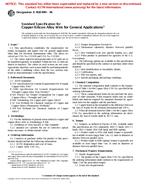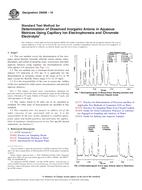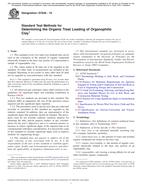1.1 This practice establishes a uniform standard for computing the interlaboratory quantitation estimate associated with Z % relative standard deviation (referred to herein as IQE
1.2 IQE
1.3 The fundamental assumption of the collaborative study is that the media tested, the concentrations tested, and the protocol followed in the study provide a representative and fair evaluation of the scope and applicability of the test method as written. Properly applied, the IQE procedure ensures that the IQE has the following properties:
1.3.1 Routinely Achievable IQE ValueMost laboratories are able to attain the IQE quantitation performance in routine analyses, using a standard measurement system, at reasonable cost. This property is needed for a quantitation limit to be feasible in practical situations. Representative laboratories must be included in the data to calculate the IQE.
1.3.2 Accounting for Routine Sources of ErrorThe IQE should realistically include sources of bias and variation that are common to the measurement process. These sources include, but are not limited to: intrinsic instrument noise, some “typical” amount of carryover error; plus differences in laboratories, analysts, sample preparation, and instruments.
1.3.3 Avoidable Sources of Error ExcludedThe IQE should realistically exclude avoidable sources of bias and variation; that is, those sources that can reasonably be avoided in routine field measurements. Avoidable sources would include, but are not limited to: modifications to the sample; modifications to the measurement procedure; modifications to the measurement equipment of the validated method, and gross and easily discernible transcription errors, provided there was a way to detect and either correct or eliminate them.
1.4 The IQE applies to measurement methods for which calibration error is minor relative to other sources, such as when the dominant source of variation is one of the following:
1.4.1 Sample Preparationand calibration standards do not have to go through sample preparation.
1.4.2 Differences in Analystsand analysts have little opportunity to affect calibration results (as is the case with automated calibration).
1.4.3 Differences in Laboratories(for whatever reasons), perhaps difficult to identify and eliminate.
1.4.4 Differences in Instruments(measurement equipment), such as differences in manufacturer, model, hardware, electronics, sampling rate, chemical processing rate, integration time, software algorithms, internal signal processing and thresholds, effective sample volume, and contamination level.
1.5 Data Quality ObjectivesTypically, one would compute the lowest % RSD possible for any given dataset for a particular method. Thus, if possible, IQE
Product Details
- Published:
- 02/10/2000
- Number of Pages:
- 15
- File Size:
- 1 file , 410 KB


